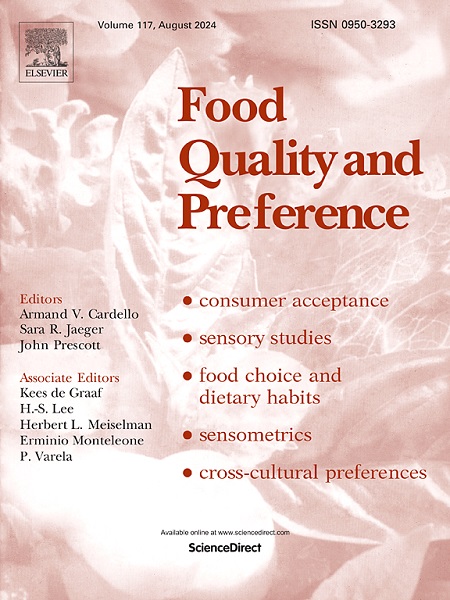在幼儿教育环境中测试食物供应和浪费审计协议(NUTRI_WASTE_ECEC):一项等效研究。
IF 4.9
1区 农林科学
Q1 FOOD SCIENCE & TECHNOLOGY
引用次数: 0
摘要
幼儿教育和保育环境(ECEC)是重要的食物环境,幼儿在幼儿教育和保育环境中通常获得约一半的每日营养需求。ECEC之前的研究发现,菜单质量差,食物浪费严重,这对人类和地球健康都有影响。制定了自我管理的称重方案(NUTRI_WASTE_ECEC),从消费前(服务浪费)和消费后(餐盘浪费)两个层面审核食物供应和浪费。本研究检查了在不同管理员之间使用协议收集的数据的准确性。数据由一名训练有素的研究员和六名研究助理在一所大学食品实验室(在模拟ECEC设置的条件下)收集。按照NUTRI_WASTE_ECEC方案,分别对原料和准备好的食材以及餐盘和餐盘废弃物进行称重和拍照。使用等效检验来验证受过培训的研究人员和研究助理之间的平均%差(和90% CI)是否在确定的可接受的方差范围内(±10%)。所提供的总准备食物、服务废物和盘子废物的重量比较(所有p's <;0.001)。对于原料,大多数(54项中的45项)项目(所有p's <;0.05)。因此,自我管理的NUTRI_WASTE_ECEC方案被认为与训练有素的研究人员管理的方案相比,产生了相当的结果,这些方案最常用于测量ECEC环境中的食物供应和浪费。未来的研究应侧重于不同ECEC设置下的用户体验、可行性和实用性。本文章由计算机程序翻译,如有差异,请以英文原文为准。
Testing a food provision and wastage audit protocol (NUTRI_WASTE_ECEC) in early childhood education settings: An equivalence study.
Early Childhood Education and Care settings (ECEC) are important food environments, with young children often receiving approximately half of their daily nutritional needs while in attendance. Previous ECEC research has found poor menu quality and high levels of food waste, which have implications for human and planetary health. A self-administered weighed protocol (NUTRI_WASTE_ECEC) was developed to audit food provision and wastage at both pre-consumption (serving waste) and post-consumption (plate waste) levels. This study examined the accuracy of data collected using the protocol across different administrators. Data was collected within a university food laboratory by a trained researcher and six research assistants (under conditions simulating ECEC settings). Following the NUTRI_WASTE_ECEC protocol, raw and prepared ingredients, and serving and plate waste were weighed and photographed individually. Equivalence testing was used to verify if the mean % difference (and 90 % CI) between the trained researcher and research assistants were within established acceptable margins of variance (± 10 %). Statistical equivalence was observed for weight comparisons of total prepared food served, serving waste and plate waste (all p's < 0.001). For raw ingredients, statistical equivalence was observed for reported weights of most (45 of 54) items (all p's < 0.05). The self-administered NUTRI_WASTE_ECEC protocol is therefore considered to yield equivalent results compared with the trained researcher-administered protocols most commonly used for the measurement of food provision and wastage in the ECEC setting. Future research should focus on user experience, feasibility and utility in different ECEC settings.
求助全文
通过发布文献求助,成功后即可免费获取论文全文。
去求助
来源期刊

Food Quality and Preference
工程技术-食品科技
CiteScore
10.40
自引率
15.10%
发文量
263
审稿时长
38 days
期刊介绍:
Food Quality and Preference is a journal devoted to sensory, consumer and behavioural research in food and non-food products. It publishes original research, critical reviews, and short communications in sensory and consumer science, and sensometrics. In addition, the journal publishes special invited issues on important timely topics and from relevant conferences. These are aimed at bridging the gap between research and application, bringing together authors and readers in consumer and market research, sensory science, sensometrics and sensory evaluation, nutrition and food choice, as well as food research, product development and sensory quality assurance. Submissions to Food Quality and Preference are limited to papers that include some form of human measurement; papers that are limited to physical/chemical measures or the routine application of sensory, consumer or econometric analysis will not be considered unless they specifically make a novel scientific contribution in line with the journal''s coverage as outlined below.
 求助内容:
求助内容: 应助结果提醒方式:
应助结果提醒方式:


